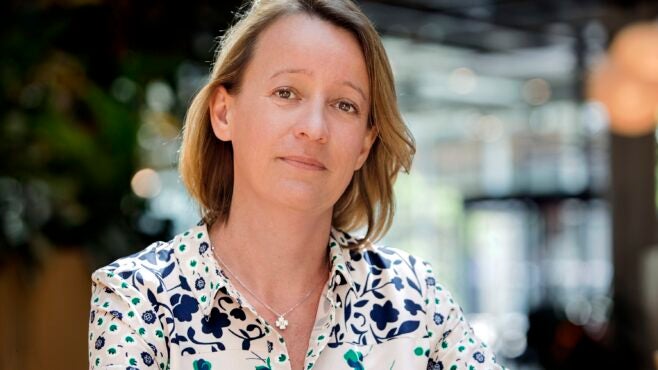

Puleng Ndjwili-Potele of UNEP FI says it is challenging to align businesses with SDGs other than climate targets, and financial education is no different. (Photo courtesy of UNEP FI)
- So far, 28 banks have signed up to a new UN Environment Programme Finance Initiative to promote universal financial inclusion and health.
- Data collection is a key challenge in this area, and something banks such as ING are working on.
- With fintech firms and challenger banks making inroads in the sector, established lenders must innovate to stay relevant.
Financial hardship is not an issue confined to poorer countries, but it is relative depending on location. The big increase in social and financial vulnerability as a result of the Covid-19 pandemic is, though, a well-documented issue the world over. This has raised concerns about the ability of many households to meet their day-to-day needs or to cope with future monetary difficulties.
One way to address such issues is financial inclusion: ensuring that financial services are available to those who need them. But financial education is also necessary, even in advanced economies, if many are to manage their money effectively.
That is something financial service providers – and other organisations – are increasingly recognising. Established players face challenges in the form of financial technology companies coming into the sector, and the whole industry is grappling with the challenge of gathering and assessing data in this area.
New UN Environment Programme project
Globally, 28 banks have signed up to a new project launched in December by the UN Environment Programme Finance Initiative (UNEP FI) to encourage the banking sector to embed, set and report on targets related to financial inclusion and financial health.
The UNEP FI sees both as cornerstones of international development and essential to meeting many of the 17 Sustainable Development Goals (SDGs), such as ending poverty (SDG 1), gender equality (SDG 5) and sustainable and inclusive economic growth (SDG 8).
“At the moment, all the regulatory focus is on the environmental part of disclosures, which is why all funds doing ‘E’ are in focus [and] the ‘S’ is not touched so much,” says the manager of a fund focused on pure-play education technology who asked not to be named. “But if you look at where our clients would like to invest, they’re going through all the SDGs to try and find funds that target each of those issues. It’s clear how to analyse the environmental impact, but less clear with what you do with social.”
Accordingly, Dutch group ING joined the UNEP FI’s new scheme in recognition of the risks posed by insufficient financial inclusion and health both to its own banking book and sustainable development in general.
Four in ten (42%) households are struggling to make ends meet in the EU, “showing many of our customers are facing financial difficulties”, says Anne-Sophie Castelnau, global head of sustainability at ING. A quarter of the bank’s customers in the Netherlands and 37% of those in Belgium have a financial savings buffer of €2,000 or less, leaving them vulnerable to future shocks, the bank’s research indicates.
Seeking to measure social impact
After Cop26 intensified the focus on environmental issues, banks are now turning their attention to improving the reporting and measuring of the social impact of their operations. While financing instruments such as social and SDG-linked bonds are already widely used, many banks are at the early stages of their journey when it comes to measuring their social impact.
In the UNEP FI’s 'Collective Progress Report' published in October, banks identified financial health and inclusion as one of their top three sustainability challenges, and an area where they could have a bigger impact, says Puleng Ndjwili-Potele, banking lead at the UNEP FI.

Anne Sophie Castelnau of ING says 42% of households are struggling to make ends meet in the EU. (Photo courtesy of ING)
ING’s approach to the financial health of its customers forms part of its “social pillar”, says Castelnau. “We’ve chosen to engage with our peers to try and build a sector approach, like we did for climate, that is in favour of standardisation.”
The aim, she tells Capital Monitor, is “to work together to define a way to track the impact we can have, share best practice and [provide] more support to our customers”.
The UNEP FI says its new scheme is the first of its kind to promote universal financial inclusion. It defines financial inclusion as “democratising financial services and leaving no one behind” and financial health as “a state in which a person or organisation can smoothly manage their current financial obligations and have confidence in their financial future”.
After signing, banks have 18 months to set targets, on which they must report annually. Signatories also commit to making changes that might include providing affordable bank accounts, accessible ways of making payments, suitable credit offerings, financial education or improved credit and risk policies to mitigate over-indebtedness.
Financial education, literacy and inclusion are logical focus areas for the banking sector in emerging as well as developed markets (see table below). Fostering a broader, more clued-up and resilient customer base will improve returns by boosting credit growth and reducing the amount of loan impairments and defaults.
Many banks – such as BBVA, HSBC, ING and Santander – already have extensive programmes supporting financial inclusion.
Santander, for example, says it aims to provide services to ten million people between 2019 and 2025 through its Superdigital mobile banking platform, Prospera microfinance programme in Brazil and Tuiio financial inclusion programme for low-income householders in Mexico. Its campaigns have reached four million people to date and the bank has extended €469m to micro-entrepreneurs in 2020.
In November, meanwhile, HSBC said it had opened 150 bank accounts for Afghan settlers arriving in the UK after the Taliban’s takeover in August.
Rising focus on financial health
Financial inclusion is core to the strategies of many banks in emerging markets, where the proportion of unbanked tends to be higher than in developed economies. There are still some 1.7bn adults globally without a bank account, the UNEP FI says.
Yet the sector also recognises the need to ramp up its efforts on improving financial health – to help people make better use of financial services and focus more attention on financial health by improving numeracy skills, financial literacy and capacity for funding entrepreneurs.
“Financial inclusion is a simpler concept [than financial health] and an area that banks are working in quite a lot,” says Ndjwili-Potele. But the latter is a “pretty new” concept for a lot of banks.
Spain’s BBVA runs a centre for financial education. In the UK NatWest offers MoneySense, a long-standing free financial education resource, and Barclays launched Money Mentors in 2019, offering online information and practical learning related to budgeting, managing debt and credit scores.
In South Africa, meanwhile, banks are required by the regulator to run financial literacy programmes for the financially excluded. One example is Standard Bank’s WalletWise programme, initiated in 2009.
Data challenges
Data collection, measurement and setting hard targets is a major challenge for financial health, as it is for many social indicators. The UNEP FI is calling for a coordinated effort to establish a clear framework and best practice across the banking sector.
It is clear how to align businesses and operations with climate targets, but a lot less so for other SDGs, says Ndjwili-Potele. “Where government policies are less clear, [such as on financial health] this is even more of a challenge.”
Financial health needs to be measured more sharply, such as in respect of what a good project or innovation does. Stefan van Woelderen, ING
Targets will vary across countries, take into account policy frameworks and should be based on the needs of the most vulnerable groups, the UNEP FI says. In the UK for example, banks could align targets with the UK Financial Wellbeing strategy launched in January 2020.
Financial health “needs to be measured more sharply”, such as in respect of what a good project or innovation does, says Stefan van Woelderen, financial health lead at ING.
ING will initially focus on understanding the impact its products and services have on customers before setting targets in two areas: problematic debt and savings. Key performance indicators (KPIs) may include the extent to which customers are in overdraft or the number of people defaulting on loans.
Ripe for disruption
Should it gather the same momentum as its climate initiatives, the UNEP FI’s framework on financial inclusion and health may help set a universal standard on disclosure among traditional banks. However, lenders will need to act fast to retain leadership – and customer growth – in this area.
Both financial inclusion and financial education are ripe for disruption from fintechs and challenger banks. The growth of mobile money services such as Kenya’s m-Pesa is well documented, but fintechs are now building in learning capabilities and catering for ever younger customers too.
San Francisco-based Step, a bank targeting digitally savvy teenagers, has signed up two million customers since it was launched in January 2019. Step allows children under 18 access to a bank account and spending card if a parent or guardian also signs up as a sponsor. It also aims to teach financial literacy and responsibility.
In the United Arab Emirates, Abu Dhabi Islamic Bank (ADIB) last year launched a bank account for teens with ‘gamified’ built-in learning capabilities called Amwali. It aims to teach the basics of financial literacy – how to save or borrow money, how to spot financial crime and so on. Users unlock new features as they progress to higher levels. ADIB expects the app to grow from 10,000 users now to 100,000 by the end of this year, chief operating officer Sandeep Chouhan tells Capital Monitor.
As ever more individuals gain access to mobile, internet-enabled devices, the convenience of managing money is only growing. It is in banks' long-term interest that they help customers understand how to save as well as spend it.






